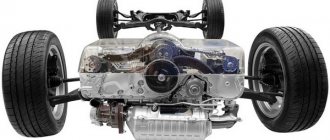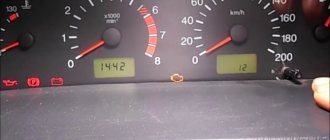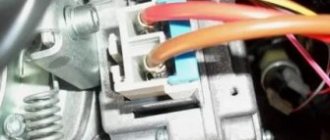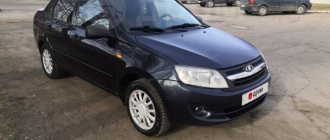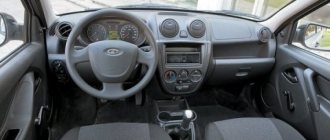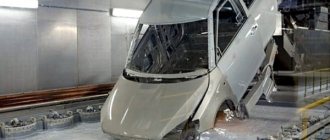An experienced motorist can easily distinguish between normal vibrations when accelerating and a cause for serious concern. In the first case, an increase in engine speed and vehicle speed will inevitably affect the level of comfort; in the second case, the source of increased shaking will be a specific malfunction.
Please note that such symptoms require diagnosis and immediate elimination. The point is not only an unpleasant beating on the steering wheel and an increase in noise in the cabin, but also a decrease in the level of directional stability and the likelihood of progression of the malfunction. The latter factor can lead to expensive repairs.
Let's start listing with the most banal and common reasons.
Disc imbalance
One of the reasons when the steering wheel shakes at speed may be the wheel disc itself (which is defective). Often even a new product has an imperfect shape. Serious inconsistencies in composition are also possible. Therefore, the weight differs in different areas. The central part of the wheel stretches to where the mass is greater. This is centrifugal force. Since the center will constantly shift, the centrifugal force also changes direction. Therefore, the steering wheel will vibrate through the tie rod chain at high speeds.
Vibration when accelerating
This is terrible, especially when you need to accelerate quickly, for example if you need to overtake another car. Often when you press the pedal, acceleration is jerky and uneven. To make a correct diagnosis, you need to follow a few simple steps.
Check the oil level in the gearbox. Surprisingly, low transmission oil levels cause vibrations and shaking during acceleration. The car may also noticeably lose its dynamic characteristics. Jerking when pressing the accelerator pedal - this can also be a consequence of a lack of oil.
A dirty automatic transmission filter leads to various unpleasant effects. You can do the replacement yourself or use the services of specialists.
A worn driveshaft is a guaranteed noticeable vibration of the car when accelerating. The weak point here is the cross. Replace the part if necessary, otherwise it may cause more serious damage.
Wheel deformation
The degree of their deformation quite significantly affects beats or vibrations. The disc can be damaged if you drive carelessly over potholes and potholes. A crooked wheel can be identified by visual inspection. They look at the rim of the disc and look for dents. Most often, deformations are on its inner side. Cast wheels, unlike stamped ones, are much less likely to deform.
Therefore, if the steering wheel shakes at speed, you should immediately carefully check the wheels. The disc may be dented. It is also recommended to check the wheel on a stand. But it is not always possible to identify curvature in this way. If the wheel is very crooked, then vibration throughout the body will indicate this.
When old or deformed tires are installed on the rims, this may be one of the reasons for shaking. At the same time, the body may also vibrate. Symptoms can be confused with deformed discs. So, at low speeds only the steering wheel can shake. As you gain speed, both the steering wheel and the body will shake. The greater this deformation, the more significant the vibrations will be. They are also felt at low speeds. The way out of this situation is to replace the wheels or tires.
Candles, “donut” and all the others: why vibration appears at idle
About the essence of the phenomenon
Today we will talk specifically about the vibration that appears at idle, for example, when stopping at traffic lights or in traffic jams.
And let’s also try to find the difference between the vibration of a cold and warm engine. But again: only the vibration that occurs when stopping or parking. It is logical to assume that the engine is to blame for the vibration (when stopped, nothing seems to be working in the transmission). This is almost correct, so let's start with the motor.
It doesn't spin much!
Indeed, the main cause of vibration is low idle speed. The nature of the vibration will be more or less uniform. Therefore, first you need to pay attention to the tachometer (or better yet, to a more accurate scanner) and find out whether the idle speed has dropped. Why they might drop is another topic, but if the idle speed is really below normal, you will have to do some diagnostics. Although on some cars the idle speed is naturally low, so it is difficult to deal with such vibration (for example, on a Honda Civic). So here we are dealing with a type of norm. Well, if the idle numbers really dropped, we need to deal with it.
Just don’t forget that idle speed can decrease significantly when many consumers are turned on (due to an increase in the load on the generator). And if during the first cold weather you suddenly notice that the car is shaking a little, try turning off the heated seats, windows, mirrors, steering wheel and whatever else is there. If after turning them off the vibration disappears, there is no need to worry - this is normal.
Another thing is uneven vibration, in which the car may also shake a little. Here, most likely, you will have to slip into banality - usually this is a sign of triplicity. Theoretically, the Check Engine light will also tell you about this, but not on all cars it lights up for any reason, so it can ignore isolated misfires. The solution is the same - diagnostics. Maybe it's time to change the spark plugs, maybe the injector is leaking or some sensor is acting up. In general, everything is clear about tripling - I won’t repeat it.
A more serious reason may be uneven engine operation due to reduced compression in one or more cylinders. Even if there are no malfunctions in the ignition system and there is still enough compression to ignite the air-fuel mixture, a significant difference in compression in one of the cylinders leads to an increase in vibration at idle. While driving, this may not be noticeable, and not everyone immediately feels the decrease in dynamics, but at idle the engine may already shake a little. Again, we go to the service center, measure the compression and draw conclusions. This is especially true for owners of diesel cars, the smooth operation of whose engines depends especially heavily on compression.
And, of course, don’t forget about the timing belt. Jumping the belt by one tooth does not always cause an error light on the panel, but it can shake well. Chain stretching also affects the vibration of the motor, so in these cases checking marks or phase synchronization with a scanner will not be superfluous.
All of the above are very common causes of vibration at idle. But, fortunately, in life the most common cause of such vibration is easier to solve and has almost nothing to do with the motor.
"I'm tired, I'm leaving"
On older cars, vibration of this kind almost always occurs for a simple reason - due to wear and tear on the engine mounts. As we all know, at least one of the engine mounts (or mounts) in a modern car is oil-based. The oil can escape from it due to a rupture or cracks, after which the engine “lies” on the body. The engine lying on the body jumps so that the vibration will be very noticeable. Therefore, first of all, you need to check the filled support.
Why, with a torn mount, can the engine shake the car not constantly, but only at idle? Usually for one simple reason: as soon as the engine begins to produce torque while driving, it tilts a little. And at this moment it moves away from the body. And when it stops, it falls back on the pillows (on their remains) and again begins to shake the whole car.
However, all simple rubber supports also lose their properties over time. Rubber hardens over the years and readily transfers vibrations to the body. And this is precisely what is most noticeable on a cold engine: if you stand in traffic jams, and even in the heat, the rubber parts become a little softer, and the vibration seems to decrease. And on a cold engine it appears again. The solution to the problem is simple - replacing the supports. Moreover, you will probably have to change all the supports at once, including the gearbox mounts (if there are any), because in this case the filthy sheep really spoils the whole herd and shakes the body even with all the other supports in good working order. Unfortunately, everything in this world ages over time, and wear and tear on the supports is inevitable. And it’s bad that analogues are usually noticeably worse than original pillows and either do not solve the problem or do not solve it for long. And original supports are often quite expensive.
A good way to check whether the mounts on a car with an automatic transmission are not damaged is to compare the vibration when the selector is in Park or Neutral and in D mode with the brake pressed. If the vibration is much more noticeable in “drive”, then almost one hundred percent the reason lies in the supports. True, there is one “but”: the box must be in good working order. Otherwise…
What if it's not the motor?
A more rare cause of vibration on a car with an automatic transmission is wear of the “donut” (torque converter). If he is about to “leave the chat,” then when he stops in “drive” and presses the brake, a vibration also appears. But, fortunately, this happens less often than wear of the liquid motor mount, and the bouquet of symptoms is richer. Here you usually encounter jerks during acceleration and straight-line movement, and a hum.
If everything has been checked a hundred times and of all the suspects, only the “donut” remains, it makes sense to start by changing the oil in the machine. Perhaps with fresh oil the situation will change for the better. In winter, you can check this circuit quite simply: immediately after starting the engine, turn on D and see if the engine is trying to stall when the brake is pressed. If it stalls, then instead of ATF there is some kind of impossible liquid in the box. It’s just a pity that this test requires a frost of 20 degrees, and it’s still a long wait.
Everything that spins
And finally, another reason for strange vibration is a malfunction of the mounted units and their drives. Of course, it will not be possible to detect vibration from a crooked generator pulley - this is not the case at all, and the symptoms will be different (it’s more likely that the belt will break than the car will shake). But sometimes it happens that something under the hood turns more difficult than it should. It could be a generator, a pump, an air conditioning compressor - anything.
It will not be the bearing that vibrates (this cannot be noticed), but the motor itself, which becomes difficult to operate at idle. This happens very rarely, but just in case, I’ll give an example from a friend’s service: the engine of one Ford Fusion did not show any errors, but was shaking like in a fever. The culprit turned out to be the pump. Moreover, usually when it wears out, it first simply flows and jams, but here it simply turned difficult and unevenly. And this was enough for the low-volume engine to have a dance on the pillows. I think this is a rare exception, but still, if you encounter this once, there is a chance that someone else may encounter this too.
What to be afraid of?
The vibration itself is, of course, unpleasant. It’s not for nothing that many automakers now install active engine mounts, which change operating parameters depending on the speed and load on the engine. You can forget about comfort with vibration, but this is not the most important thing. The main thing is that sometimes this vibration can warn of a more serious malfunction or prevent it. Take the same Fusion: if the owner had not shown concern in time, the pump would have jammed someday anyway, and the consequences could have been unpleasant. A timing belt jump or chain stretching also does not promise anything good, and engine tripping and an unexpected decrease in power can be downright dangerous.
In addition, the vibrations that are transmitted to the body do not in any way prolong the life of the wiring and connectors. Especially if this wiring is already old and dry. Fixation points, wiring in harnesses, bends and connections are frayed. And that's bad too. So you shouldn’t ignore the appearance of vibration - it definitely has a reason, and this reason must be sought and eliminated in any case.
Suspension and steering
Excessively worn car suspension parts greatly affect how the car contacts the road. Ball joints, steering rods, and wheel bearings have a certain amount of play. As they move, they can cause imbalance. Sometimes all suspension elements are subject to deformation - silent blocks, levers, stabilizer.
If everything is fine with the tires and wheels, but the steering wheel shakes at speed, then it is necessary to check and replace worn parts of the chassis. Vibrations at low speeds often occur due to play in the rack. It is recommended to check the tie rods.
Why do engine mount silent blocks break?
Due to an unsuccessful design, silent blocks are in no way protected from reagents, dirt and aggressive environmental influences. Therefore, they quickly wear out and tear.
After replacing the mount, engine vibration disappears, the car begins to respond faster to pressing the gas pedal and the ride becomes more comfortable. Such repairs also reduce the likelihood of breakdowns due to play.
If you do not have time to replace the support yourself, you can entrust the repair to the specialists of StoVest St. Petersburg. The service will take 5-10 minutes to replace the part.
Source
Steering wheel shakes when braking
The VAZ-2170 (like many other models) has front disc brakes. Therefore, it is worth considering possible problems in this case. When the steering wheel shakes when braking at speed, there are three reasons. These are crooked wheels, worn brake discs or wheel bearings. If the brake disc is curved, then the pad will follow the shape of this surface. Thus, due to the curvature, the wheel rotates unevenly. This happens due to great inertia. If you start to rock the wheel, it will resist. At speed this resistance is especially high. Therefore, vibrations are felt both on the steering wheel and on the pedals.
Rubber
There are often cases when vibration when accelerating appears due to the installation of low-quality tires. Most often these are tires from budget and extra-budget manufacturers. The peculiarity of such rubber is that when checking on a balancing stand, a discrepancy that causes discomfort when driving a car may not be noticed. In the second case, balancing only temporarily delays the reappearance of vibrations. Only replacing the tires will solve the problem.
The next reason for the appearance of unwanted vibrations is typical for owners whose car is shod with low-profile tires. The side cord of such tires does not have the rigidity and elasticity that is inherent in civilian versions of tires. Therefore, prolonged downtime, especially in the warm season, can cause temporary deformation of the tire at the point of contact with the road surface. Therefore, vibration during acceleration may be observed for a short time after the start of movement. The first kilometers should be covered with extreme caution.
Uneven wear
Asymmetric wear of the tread on the tire and the appearance of “bumps” will lead to the fact that the suspension elements will experience additional vibration load. Of course, the whole car as a whole will vibrate at speed.
Wheel bearing
If at speed you not only vibrate, but also hear a hum, then you can say with confidence that the wheel bearing has failed. The situation is quite normal, so at the beginning of the problem, operating the car will not cause any consequences. But there’s no point in delaying repairs. Overly worn bearings can fly apart, which will certainly lead to disastrous consequences.
A malfunction of this unit is indicated by wheel play. To diagnose, hang up the wheels and shake each of them in the longitudinal and transverse directions. The play will be a signal for an immediate replacement.
Suspension and steering
Worn suspension elements cannot cause constant or periodic vibrations when driving. Their purpose is to dampen shocks that come from the road surface. Therefore, a car with a faulty suspension can scour the road, make squeaks or knocks when turning the steering wheel, or make dull or loud “echoes” of obstacles overcome.
But keep in mind that in the case of worn rubber products, hinged, elastic elements (ball joints, support bearings, shock absorber struts, steering tips and others), the beating, for example, from unbalanced wheel rims will be felt much stronger.
To safely drive a car, it is worth solving the problem comprehensively.
In the case of steering, variations in the design of different systems do not allow us to draw clear conclusions. From the personal experience of the author of the article, I recall a case when the steering rack guide bushing, the so-called “binoculars,” was to blame for the runout at speed (more so when braking).
Where does steering wheel wobble come from?
Steering wheel beating at the moment of braking means spontaneous jerking of the steering wheel in different directions. In especially advanced cases, the vibration is so strong that the driver has to literally catch the car on the road. At speeds above 50 km/h, the phenomenon creates a real danger for vehicle passengers.
Since the steering wheel is rigidly connected to the front wheel hubs through a rack and ball ends, the source of the problem must be sought in the chassis and braking system of the car. The main causes of strong vibration lie in various defects of the brake disc:
- the working part of the product is deformed and has a wavy surface;
- due to the impact, the disk was damaged and cracked;
- The spare part was originally defective or installed incorrectly.
It is no coincidence that the front brake discs are named as the culprits. As soon as the working surface of the part changes its shape a little or gets a defect, after the pads are activated, the front wheels will begin to wobble, repeating the rotation of the uneven element. The steering wheel hits even harder when braking at high speed, as the speed of the front wheels increases.
Steering wheel wobble on bumps
If the steering wheel hits on bumps, then in addition to the above-mentioned problems, the steering mechanism may also break. The following reasons for the steering wheel beating on bumps can be identified:
- the steering shaft crosspiece is worn out (the problem can be solved by replacing or repairing it);
- excessively long suspension of the car during repairs (the sagging suspension will return to its original state in about 12-24 hours and the beating will disappear);
- wheel alignment (not a common cause of runout).
The beating of the steering wheel on bumps is often accompanied by a knocking sound in the steering column. It often turns out that by eliminating the cause of the knocking, the beating goes away.
If the steering wheel shakes when braking, at speed or on bumps, then you should go to a service station to diagnose the car and only then draw any conclusions. It is impossible to know for sure that the problem is in the CV joint or that the steering mechanism is damaged; for a reliable and objective answer, a comprehensive diagnosis of all systems is necessary.
Vibration of various elements of the car inevitably occurs during operation, when the moving parts of the chassis and transmission gradually wear out. But among such malfunctions, there is one dangerous malfunction - the steering wheel wobbles when braking. The more the steering wheel jerks after pressing the brake pedal sharply, the higher the likelihood of losing control and flying off the road at a decent speed. To avoid the described emergency situation, it is worth studying the nature of the problem and how to solve it.
Other causes of vibration
Steering wheel vibrations that are not associated with the car jerking in different directions appear for the following reasons:
- One of the vehicle's process fluids, for example, transmission oil, got on the pads as a result of oil seal wear. Possessing significant viscosity, the lubricant adheres well to any surface and disrupts the normal operation of the brakes when the pedal is pressed sharply.
- The internal elements of the steering rack have worn out, and significant play has appeared.
- The steering rod ball pins have become unusable.
- Inoperability of shock absorbers and front struts. Vibration on the steering wheel is felt when braking sharply and at the same time entering a turn.
Note. Problems associated with wear of ball joints and shock absorbers also appear on the wheels of the rear axle. Most often, brake fluid gets on the pads, the reasons are faulty working cylinders and leaky rubber cuffs.
A strong side impact of any wheel on a high curb (for example, due to ice or an accident) can lead to deformation and subsequent vibration. The main load is taken by the disk, wheel bearing and various suspension joints. Any of the listed parts can become cracked and cause the steering wheel to vibrate during braking.
Out of balance due to mud or snow
One of the most likely reasons is that the disk is simply clogged with dirt or snow - in this case, the beating appears temporarily, it can stop literally immediately after gaining speed and does not appear again or after several minutes of driving. Determining the presence of dirt is easy in the case of alloy wheels and quite difficult in the case of steel wheels (which, as a rule, have rather small ventilation holes, and even decorative caps can interfere with visibility) - dirt is usually concentrated on the inside of the disk.
How is a malfunction diagnosed?
To identify the runout of one of the front wheels, you will need a jack, wheel chocks and a wheel wrench. The diagnostic procedure is as follows:
- Park the machine on level ground and pull the handbrake all the way. Additionally, secure the car with boots placed under any rear wheel.
- Jack up the front wheel until it hangs off the ground. On vehicles with front-wheel drive and all-wheel drive, be sure to move the gearshift lever to neutral.
- Rotate the suspended rim with your hands. If you feel stuck in a certain position, remove the wheel and check that the uneven disc is rubbing against the pads, causing strong vibration when braking.
The essence of the diagnosis is simple: after operation, the brake pads move back just enough to free the rotating surfaces. The lining must be forced apart to its maximum open position. If the metal working part is bent, then when rotating the part will begin to get stuck between the pads.
Advice. It is not a fact that jerking of the steering wheel in different directions is caused by deformation of one disc. It is likely that the second element is also bent. Therefore, be sure to check both front mechanisms for defects. At the same time, inspect the parts for cracks (especially after a side impact).
If the vibration does not cause the car to deviate from a straight path while driving and does not cause the steering wheel to twitch, check the suspension and chassis components. Drive the vehicle into the inspection ditch and jerk the steering rods to check for play. The performance of shock absorbers is checked by rocking the car up and down with body weight. After applying force, the machine should swing no more than 1 time.
How to solve a problem?
The only way to get rid of the noise and vibration of the motor is to replace the part.
To forget about engine vibrations for a long time, we recommend installing a reinforced rear support. It is noticeably stronger than standard and can easily withstand the workload. This solution has only one drawback - the price. Such a support in our store costs 3,500 rubles without discounts.
There is also a more budget option - a simple rear engine mount. It costs 1,700 rubles without discounts. The service life of the part is the same as that of a standard spare part. With a successful combination of circumstances, it will last 50-150 thousand km. mileage
Ways to solve the problem
If you suddenly feel that the steering wheel is vibrating a little at speed, then do not rush to go to a service station and waste your money. Considering the reasons that cause the steering wheel to wobble, you can try to eliminate it yourself. To do this, follow these steps:
- Check the tire pressure and adjust it to normal if necessary.
- Carefully inspect all wheels for damage. Perhaps this is precisely the problem, and the beating is caused by a dent, crack, etc.
- Check all bolts and tighten them if necessary.
- Change the wheels on the front and rear axles.
- Raise the car and reach the speed at which the wobble begins. This way you can figure out which wheel is having problems. After that, remove the required disc, and again pick up speed, while simultaneously observing the brake disc. If the vibration does not disappear, then the CV joint or the disk itself may be faulty.
How to reduce engine vibrations
If the car has a carburetor, then to reduce vibrations this element requires careful adjustment, after which the idle speed is set. At the same time, the fuel pump is checked.
On injection cars, the fuel pump, injectors, electronic control system sensors, and fuel pressure regulator in the fuel rail are also checked. Additionally, it is recommended to clean the throttle valve and check the idle air valve, which supplies air bypassing the throttle valve at idle. Vibration of a diesel engine at idle may indicate certain malfunctions of the fuel injection pump or injectors, which will also require careful diagnosis and subsequent adjustment.
What else should you pay attention to?
Vibration when accelerating can be felt due to unreliable mounting of the engine and exhaust system parts. It is better to perform this check with the engine running and then turned off. There are also cases when shaking is caused by a damaged radiator fan.
Next, check the attachment. Often the problem can be solved by replacing the drive belts or balancing the pulley. It would be a good idea to check the clutch basket and flywheel. You can do this as follows. Depress the clutch and place the selector in first gear. Next, start the engine and wait a couple of seconds. Then the lever is moved to the neutral position and the foot is removed from the pedal. Are there still vibrations? Look for the problem in the flywheel and clutch basket.
Balancing required
Runout on the steering wheel and car body with increasing speed is inevitable if the wheels are not balanced. The uneven distribution of mass relative to the center of the wheel rim leads to such consequences. The action of multidirectional centrifugal forces leads to the appearance of multi-frequency oscillations, which are felt as a beating in the car interior.
The problem may manifest itself in the following cases:
- Installing new tires. Replacing tires on rims or putting new rims on old tires must be accompanied by balancing. Even for the manufacturer, achieving ideal weight distribution and geometric parameters seems to be an extremely difficult task.
- Loss of old balancing weights. This is especially true for light alloy wheels, where the weights are glued to the inside of the wheel. Let us remember that in the case of stamped rims, the weights are placed in the outer shoulder of the rim.
- Deformation of the rubber or disk due to falling into a deep pothole, a strong impact with the curb and other similar obstacles.
- Natural imbalance. During operation, any wheel will lose its established balance. It is recommended to carry out scheduled balancing every 15-20 thousand km.
Another breeding ground for imbalance is often the constant velocity joint. It serves as a device for the movable articulation of the drive shaft and gearbox, which allows the transmission of torque in different planes (internal CV joint). At the other end of the drive shaft for articulation with the hub (outer CV joint).
Most often, the cause of vibrations lies precisely in the internal hinge. In the case of a tripod-type design, wear out of the rollers is observed. In especially severe cases, the bearing may even “fall apart”. It is also possible to produce a tripod glass.
A similar malfunction can be caused by a torn boot, which can no longer protect against dirt and dust flying from under the wheels. Therefore, periodically check the integrity of the CV joint boots.
Let's sum it up
So, common causes include wheel mounts, loose brake discs, a deformed drive shaft, constant velocity joints, and wheel bearings.
Vibration occurs when accelerating from anything. There are a lot of reasons. But if you try, you can detect them yourself and not pay for diagnostic services at a service station. But if suddenly you can’t figure it out on your own, don’t put off the decision. This leads to bad consequences. With simple steps, you will definitely find the causes of vibrations in your car and eliminate them. Take malfunctions seriously, because a neglected problem can cause an accident.
An experienced motorist can easily distinguish between normal vibrations when accelerating and a cause for serious concern. In the first case, an increase in engine speed and vehicle speed will inevitably affect the level of comfort; in the second case, the source of increased shaking will be a specific malfunction.
Please note that such symptoms require diagnosis and immediate elimination. The point is not only an unpleasant beating on the steering wheel and an increase in noise in the cabin, but also a decrease in the level of directional stability and the likelihood of progression of the malfunction. The latter factor can lead to expensive repairs.
Let's start listing with the most banal and common reasons.
Engine mounts, gearbox mounts and other reasons
This is another possible group of reasons why a car may shake when accelerating. All these problems can arise for various reasons. For example, as a result of examinations, a breakdown of one of the power unit airbags is discovered. It's easy to find out - increase the engine speed when vibrations appear.
Body vibration when accelerating from 80 km/h to 100 km/h can also occur if there is a problem with the gearbox. Testing this hypothesis is very simple. It is recommended to reach a speed of about 85 km/h, then depress the clutch pedal and watch how the car behaves. Engage third gear and release the clutch. Accelerate from 50 km in the last gear of the transmission.
If the nature of the beats does not change during all these events, the gearbox is not to blame. If the vibration level increases when the box is connected to work, then you can check its involvement.
This method is suitable for both manual transmissions and automatic transmissions. In the case of an automatic transmission, at speeds of approximately 90 km/h, turn on 3.2, D, N on the gearbox, and then monitor the operation of the automatic transmission and the car. Watch the vibrations. Most often, the fault of the box in beating is minimal, but practice shows that there is such a possibility.
